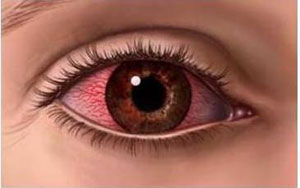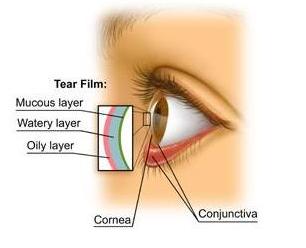Dry Eye Syndrome (KeratoconjunctivitisSicca)
Millions of people suffer from dry eyes at any given moment, and it is remarkable why millions more do not. The human cornea is very similar to a dolphin’s skin or the mucosa inside our mouths and behind our lips: it needs to be kept moist at ALL times! Once it dries, it “chaps” and becomes very sensitive: it burns constantly, feels every blink and every slight movement of the eye, it turns red, and becomes very sensitive to light. At the same time, considering over 90% of our ability to focus light comes from the “refractive” power of the Cornea, it is very easy to realize that once it dries, it affects our vision tremendously. Furthermore, once it “chaps” and its skin (epithelium) breaks, it starts to allow bacteria into it, and it can lead to devastating infections (ulcers), that left untreated, can make one blind.  Needless to say, those who wear contact lenses suffer most from dry eyes as this makes them extremely sensitive and uncomfortable. In a nutshell, people with dry eyes are very unhappy and do anything to help relieve their symptoms and improve their vision. The cornea has a natural tear layer, which is a small (~0.1mm) layer of liquid that rests on top of the lower eyelid and “rubs” on the eye everytime we blink. This is very similar to a piston of a car that allows a thin layer of engine oil to lubricate the engine walls everytime it goes up and down the cylinder shaft. This tear layer, contrary to common belief, is NOT just water: it has a small amount of “mucous” and a small amount of “lipid” (oil) mixed into it which allow this liquid to spread evenly over the Cornea, and at the same time, prevent it from evaporating quickly (sort of like a layer of oil resting over a glass of water: it prevents the water from being exposed to the air).
Needless to say, those who wear contact lenses suffer most from dry eyes as this makes them extremely sensitive and uncomfortable. In a nutshell, people with dry eyes are very unhappy and do anything to help relieve their symptoms and improve their vision. The cornea has a natural tear layer, which is a small (~0.1mm) layer of liquid that rests on top of the lower eyelid and “rubs” on the eye everytime we blink. This is very similar to a piston of a car that allows a thin layer of engine oil to lubricate the engine walls everytime it goes up and down the cylinder shaft. This tear layer, contrary to common belief, is NOT just water: it has a small amount of “mucous” and a small amount of “lipid” (oil) mixed into it which allow this liquid to spread evenly over the Cornea, and at the same time, prevent it from evaporating quickly (sort of like a layer of oil resting over a glass of water: it prevents the water from being exposed to the air).
The human cornea has a natural tear “break-up time” of about 8-10 seconds. Multiple studies have shown that people with “dry eyes” (for multiple different reasons) have one or more of these components missing: they either don’t secrete enough “water” (“aqueous deficiency”), they don’t secrete enough mucous (“mucin deficiency”), or they don’t secrete enough “oil” (“lipid deficiency”).  Obviously, the aqeous deficiency is more common, and that is why “artificial tear” sales exceed billions of dollars annually. The challenge behind treating dry eyes is that, in those affected by causes other than just “aqueous deficiency,” artificial tears are completely useless and ineffective! People instill drop after drop (as frequently as every half an hour) and still feel no relief whatsoever. Unfortunately, in the hands of inexperienced eye-care professionals and those who are trained to treat dry eyes as a “knee-jerk” response (Got a dry eye? You don’t have enough tears), they get prescribed medications that are thought to improve their aqueous “production” (i.e., Restasis). Obviously, in those who do not have aqueous deficiency, Restasis does not improve things at all. Multiple studies have shown that decreasing inflammation in the eyes and eyelids would help things, and that is true, but still, there are people on topical corticosteroids AND restasis who do not feel complete relief. The newest trend in combating dry eyes is to take dietary supplements which improve the omega-3 fatty acids (e.g., Salmon and Flax Seed Oil) stores in our bodies. In the right patient, these supplements help tremendously, but there are STILL those who feel their eyes are not “oily enough.” Here is where eye-press is effective in treating dry eyes: multiple studies have shown that the application of heat to the eyelids, improves people’s tears’ lipid layer SIGNIFICANTLY. The heat allows the lipid inside our eyelids’ oil glands to “melt away” (like butter melting) and nicely coat the eyes (very similar to applying vaseline to chapped lips). There is debate with respect to the frequency and duration of heat application, but those who suffer from severe dry eyes automatically develop a good sense of how often they need to repeat this exercise to feel better, and “titrate” their treatment to the minimum number of times that works best for them, but in general, eye-presses applied once-twice daily can provide great relief.
Obviously, the aqeous deficiency is more common, and that is why “artificial tear” sales exceed billions of dollars annually. The challenge behind treating dry eyes is that, in those affected by causes other than just “aqueous deficiency,” artificial tears are completely useless and ineffective! People instill drop after drop (as frequently as every half an hour) and still feel no relief whatsoever. Unfortunately, in the hands of inexperienced eye-care professionals and those who are trained to treat dry eyes as a “knee-jerk” response (Got a dry eye? You don’t have enough tears), they get prescribed medications that are thought to improve their aqueous “production” (i.e., Restasis). Obviously, in those who do not have aqueous deficiency, Restasis does not improve things at all. Multiple studies have shown that decreasing inflammation in the eyes and eyelids would help things, and that is true, but still, there are people on topical corticosteroids AND restasis who do not feel complete relief. The newest trend in combating dry eyes is to take dietary supplements which improve the omega-3 fatty acids (e.g., Salmon and Flax Seed Oil) stores in our bodies. In the right patient, these supplements help tremendously, but there are STILL those who feel their eyes are not “oily enough.” Here is where eye-press is effective in treating dry eyes: multiple studies have shown that the application of heat to the eyelids, improves people’s tears’ lipid layer SIGNIFICANTLY. The heat allows the lipid inside our eyelids’ oil glands to “melt away” (like butter melting) and nicely coat the eyes (very similar to applying vaseline to chapped lips). There is debate with respect to the frequency and duration of heat application, but those who suffer from severe dry eyes automatically develop a good sense of how often they need to repeat this exercise to feel better, and “titrate” their treatment to the minimum number of times that works best for them, but in general, eye-presses applied once-twice daily can provide great relief.

